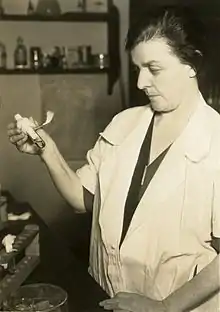Agnes J. Quirk
Agnes J. Quirk (1884-1974) was an American bacteriologist, plant pathologist, and inventor.[1] She oversaw the culturing of bacteria in the Laboratory of Plant Pathology at the United States Department of Agriculture's Bureau of Plant Industry.[2] She received a patent[3] for the production of penicillin mold and jelly in 1952.[4]
Agnes J. Quirk | |
|---|---|
 Quirk in 1932 | |
| Born | 1884 |
| Died | 1974 |
| Occupation | bacteriologist, plant pathologist, inventor |
Life and career
Hired by Erwin Frink Smith, pathologist-in-charge of the Laboratory of Plant Pathology, USDA's Bureau of Plant Industry, Quirk became Smith's assistant in 1901.[5][6] Quirk's research focused on crown gall oxidation phenomena and culture mediums used in pathogenic analyses, working alongside Nellie A. Brown.[5] Her original job titles at the laboratory consisted of "laboratory aide" and "scientific assistant".[7] While a lab assistant, Quirk had three of her own assistants who helped her prepare growth media.[8] She also invented a new apparatus to help measure amounts of media more accurately and without funnels.[8]
After serving as assistant in the lab, Quirk became the head of the laboratory from 1928 to 1948.[9] At the Symposium on Bacterial Dissociation and Life Cycles of the Society of American Bacteriologists, Quirk presented "A Five-fold Technic for Producing the Filterable Form of Bacillus phytophthorus," showcasing her skills in bacteriology.[10] As a bacteriologist with experience, Quirk would share out different culturing techniques, like a formula for potato agar and a novel growth medium.[11]
Selected publications
- Quirk, A.J. & Fawcett, E. H. (1923). Hydrogen-ion concentration vs. titratable acidity in culture mediums.[7]
- Quirk, A.J. & Smith, E.F. (1926). A Begonia Immune to Crowngall: With Observations on other Immune or Semi-Immune Plants[12]
- Quirk, A.J. (1931). Pure Smooth and Rough Colony Types at Will: Science Vol. 74 Friday, November 6, 1931, No. 1923
- Brown, NA, & Quirk, A.J. (1929). Influence of bacteriophage on Bacterium tumefaciens, and some ...
- Quirk, A.J. (1934). The Correlation of Animal and Plant Bacterial Behavior and Imposed Culture Aledium Environment. Journal of Bacteriology 1934 (J. Bacteriol. 1934, 27(1):22.)[7]
References
- Staff writer (January 24, 1932). "See Them Now". The Portsmouth Times. Portsmouth, Ohio: John Clark. Retrieved May 1, 2014.
- Padgett, Edward R. (July 30, 1916). Women who do unusual work for Uncle Sam. Sunday Vindicator
- United States. Patent Office (1952). Official gazette of the United States Patent Office. The Office. Retrieved 30 March 2012.
- Ogilvie, Marilyn Bailey; Harvey, Joy D. (2000). The biographical dictionary of women in science. 2. L - Z. Taylor & Francis, ISBN 9780415920407
- Geoffrey Clough Ainsworth (30 June 1981). Introduction to the history of plant pathology. Cambridge University Press. pp. 70–. ISBN 978-0-521-23032-2. Retrieved 30 March 2012.
- Jean Beagle Ristaino (2008). Pioneering women in plant pathology. APS Press. ISBN 978-0-89054-359-7. Retrieved 30 March 2012.
- Agnes J. Quirk (1923). Hydrogen-ion concentration vs. titratable acidity in culture mediums. Retrieved 30 March 2012.
- "Norwich Bulletin". Chronicling America: Historic American Newspapers. 23 March 1916.
- "Science Source - Agnes J. Quirk, American Bacteriologist". www.sciencesource.com. Retrieved 2020-05-02.
- Society of American Bacteriologists (1931). "33rd Annual Meeting". Journal of Bacteriology. 23 (1): 14–56. PMC 533301. PMID 16559534.
- American Scientific Congress (8th : 1940 : Washington, D.C.) (1943). Proceedings of the eighth American Scientific Congress held in Washington May 10-18, 1940, under the auspices of the government of the United States of America. Dept. of State. OCLC 37532619.
- Ogilvie, Marilyn; Harvey, Joy (2003-12-16). The Biographical Dictionary of Women in Science: Pioneering Lives From Ancient Times to the Mid-20th Century. Routledge. ISBN 9781135963422.